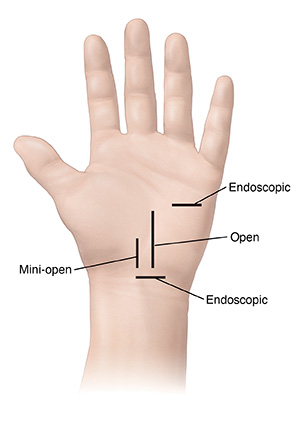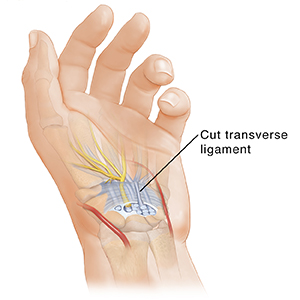Surgery may be done if your carpal tunnel syndrome (CTS) symptoms become severe. Or you may have surgery if no other treatment eases your symptoms. There are two ways CTS surgery is done. You will be told which method will be used. You’ll also be instructed on how to prepare for it. And how care for yourself when you are at home.
The goals of surgery
The 2 methods of surgery used to treat CTS are open and endoscopic.
-
Open surgery. With open surgery, your surgeon makes a cut (incision) in your palm. Standard surgical tools are used to release the transverse carpal ligament.
-
Endoscopic surgery. For this surgery, your surgeon makes 1 or 2 small cuts in your hand or wrist. A thin tube with a very small camera attached (endoscope) is inserted under the carpal ligament. Tiny cutting tools are put in there as well. The surgeon then operates while watching images on a video screen. Each procedure has the same goal: Your surgeon will relieve pressure on the median nerve. To do this, the transverse carpal ligament is cut (released).
After surgery
After your surgery, you will be taken to the post-anesthesia care unit. You will be watched there for a few hours before you go home. Your vital signs, nerve sensation, and blood circulation in your hand will be checked at this time. For the safest healing at home, do the following:
-
Keep your hand raised above heart level. This will help reduce swelling.
-
Limit hand and wrist use as instructed. You may need a wrist brace.
-
Take any pain medicine as directed.
-
Do hand exercises as directed by your surgeon or therapist.
When to call the surgeon
Call your surgeon if you notice any of the following:
-
White or pale-blue hand or nails (you pinch your skin or nail and the color doesn’t return)
-
Pain that is not relieved by prescribed medicine
-
Loss of feeling or excess swelling in hand or fingers
-
Pus-like liquid oozing out of your wound
-
Fever over
100.4 °F (38° C)
Featured in



